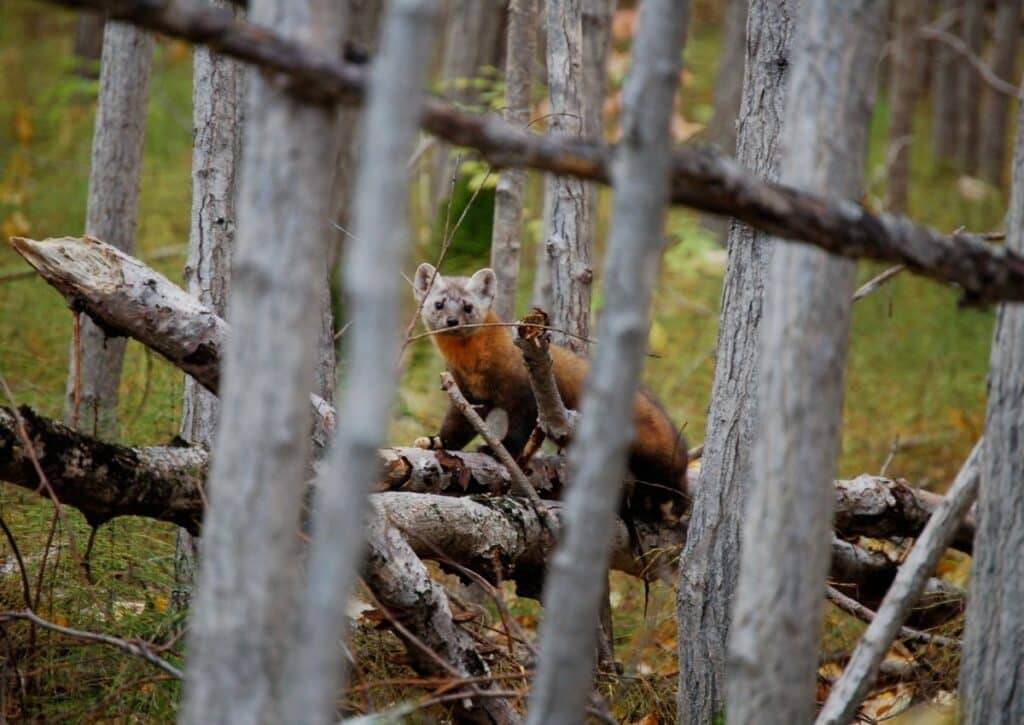Explore 18 Animals in Tahoe National Forest from a hiker's 15-year journey. Includes photos, trails, and tips for a memorable wildlife experience.
The Sierra Nevada’s rugged peaks and dense forests set the stage for Tahoe National Forest, a haven for diverse wildlife.
Every trail in this expansive forest holds the promise of a unique animal sighting, making it a must-visit for wildlife enthusiasts.
From the piercing gaze of a bobcat hiding in the underbrush to the distant call of a mountain chickadee echoing through the pines, Tahoe offers a symphony of nature at its finest.
As you plan your hiking trip, ready your binoculars and senses, because in this forest, every moment can be a brush with the wild.
Pacific Marten
The Pacific marten, a gracefully elusive mammal adorned with sleek dark fur and curious eyes, is a captivating sight within Tahoe National Forest. This petite carnivore, often overlooked amid the forest’s vast biodiversity, promises a special treat for the observant hiker.
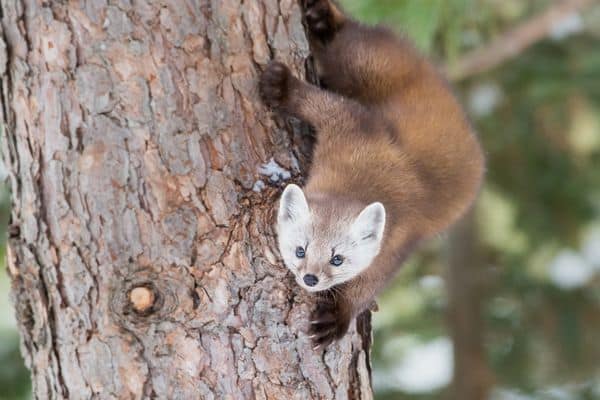
For the wildlife enthusiast determined to spot a Pacific marten, certain trails in Tahoe National Forest offer a higher likelihood. First up is the Big Bend Loop, a 3-mile trail winding through mature fir and pine forests, offering varied terrains that the martens find favorable.
The dense canopy and underbrush along this loop provide excellent hideouts and hunting grounds for the marten.
Another trail that’s gained reputation among hikers for marten sightings is the Grouse Ridge Lookout Trail. Stretching approximately 6 miles, this trail not only offers panoramic views but also journeys through habitats dense with coniferous trees, increasing the chance to see a marten darting among the branches or playfully chasing its prey on the forest floor.
Being crepuscular creatures, martens are most active during the twilight hours of dawn and dusk. As you hike, be attentive to subtle rustlings in the foliage or soft chatters; these might indicate a nearby marten.
Woodpeckers
The rhythmic drumming of woodpeckers is a sound synonymous with the vibrant life in Tahoe National Forest. These industrious birds, with their unique ability to hammer away at tree trunks in search of insects, are both fascinating to watch and vital to the forest ecosystem.
In Tahoe, you’ll find several species of woodpeckers, each with its distinct appearance and behavior. From the conspicuous Hairy Woodpecker with its bold black-and-white patterns to the rare Black-backed Woodpecker, known for favoring burned forests, there’s a diverse array awaiting the keen-eyed hiker.
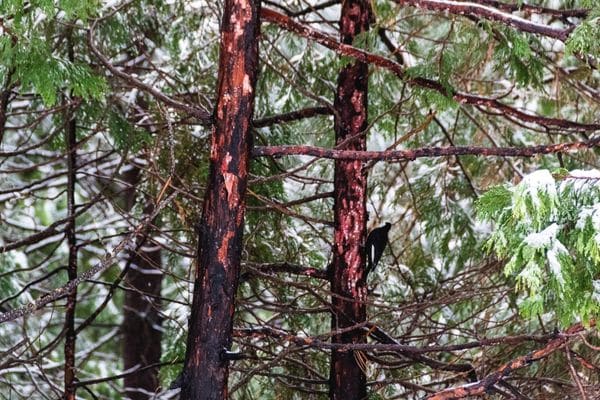
To maximize your chances of spotting these avian carpenters, consider hitting the trails that meander through dense woodlands. The Bowman Lake Trail, a 7-mile trek, is one such path where the echoing drum of woodpeckers often resonates.
The mixture of live and dead trees here attracts a variety of woodpeckers, all searching for their next meal.
Another promising trail is the Sawtooth Ridge Trail, spanning roughly 4.5 miles. This trail’s diverse habitat, with patches of old-growth forest, is particularly appealing to woodpeckers.
As you hike, keep an ear out for their signature pecking sound and an eye out for their vibrant plumage against the bark.
Remember, woodpeckers are more often heard before they are seen. Their drumming can guide you to their location. Equip yourself with a good pair of binoculars, tread softly, and let the forest’s natural rhythms lead you to these remarkable birds.
With patience and a bit of luck, you’ll be rewarded with the sight of one of Tahoe’s winged wonders hard at work.
Mountain Chickadee
Amidst the grandeur of the Tahoe National Forest, with its towering trees and sweeping landscapes, the cheerful chirping of the Mountain Chickadee often rings clear, bringing a smile to many a hiker’s face.
This small, energetic bird, distinguished by its black-and-white-striped head and lively antics, embodies the vibrant spirit of Tahoe’s avian life.
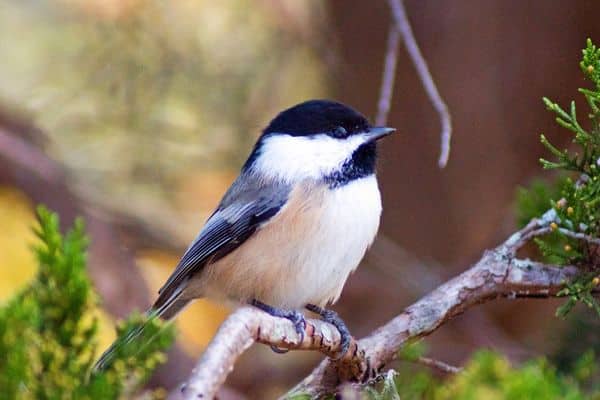
For those hoping to spot the Mountain Chickadee, the higher elevation regions of the forest with abundant coniferous trees are where you’ll likely find them flitting about. The Granite Chief Trail, a 5-mile journey, offers dense pine and fir coverage, making it a hotspot for these birds.
As you navigate the trail’s gentle ascents and marvel at the vistas, the melodic ‘chick-a-dee-dee’ call is a common accompaniment, guiding you to their presence.
Another great option is the Loch Leven Lakes Trail, stretching over 7 miles. This trail, dotted with sparkling alpine lakes, intersperses meadows with thickets of trees.
Here, the Mountain Chickadee often feeds on insects, seeds, and berries, frequently hanging upside down from branches in their characteristic playful manner.
When on the lookout for these spirited birds, it’s essential to be still and attentive. Their rapid movements and acrobatic feeding habits are a joy to watch.
So, as you traverse the trails of Tahoe National Forest, let the delightful tunes of the Mountain Chickadee serenade you, adding a musical note to your hiking experience.
Bobcats
The elusive bobcat, with its tufted ears, spotted coat, and stealthy demeanor, is one of the prized sightings for wildlife enthusiasts venturing into Tahoe National Forest.
These medium-sized wildcats, while often mistaken for their larger counterpart, the mountain lion, have a unique beauty and grace that sets them apart.
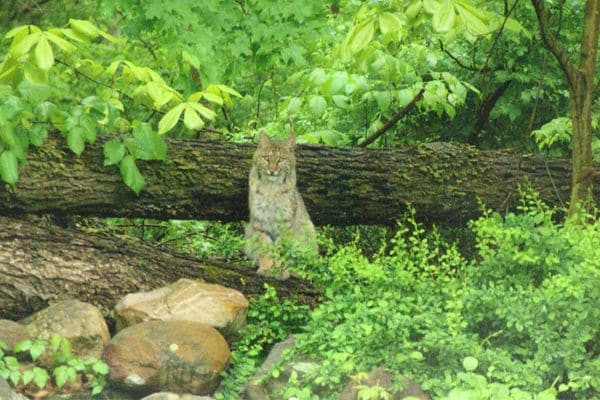
For hikers eager to catch a glimpse of a bobcat, areas of the forest with a mix of meadows and dense underbrush are prime territories. The French Meadows Trail, a 6-mile hike, offers this perfect blend of open spaces and thickets.
While the trail showcases a range of Tahoe’s natural wonders, the fringes of its meadows, especially during dawn or dusk, can sometimes reveal a bobcat stalking its prey or sunning itself.
Another promising location is the Shirley Canyon Trail, which extends for about 4 miles. This trail, with its cascading streams and interspersed woodland patches, provides an ideal habitat for bobcats to hunt and thrive.
As you tread softly along the path, be on the lookout for fresh tracks or the flicker of a tawny tail disappearing into the bushes.
Spotting a bobcat requires patience, a keen eye, and a bit of luck. They’re masters of camouflage and can merge seamlessly with their surroundings. However, the thrill of seeing one in the wild, even if it’s just a brief moment, is an unforgettable experience.
As you explore Tahoe National Forest’s vast expanses, remember that sometimes the most mesmerizing encounters are with its most secretive residents.
Mountain Lions
Among the many majestic inhabitants of the Tahoe National Forest, the mountain lion stands as a symbol of wild, untamed beauty. Also known as cougars or pumas, these large cats, with their powerful build, graceful movements, and piercing gaze, command respect and awe.
Encounters with mountain lions are rare, but not unheard of in the Tahoe region. For those with a deep interest in catching a distant, safe glimpse of these magnificent creatures, areas with rocky outcrops and dense forests serve as prime habitats.
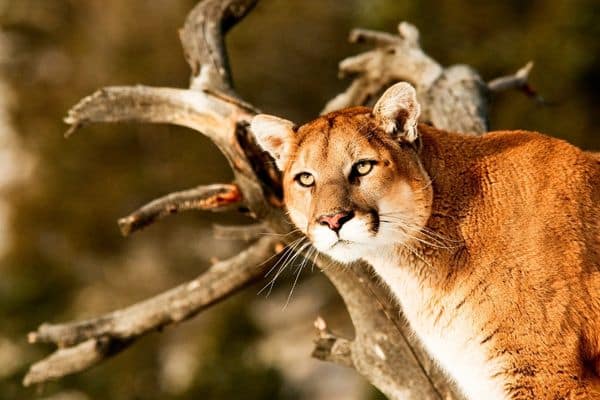
The Five Lakes Trail, a challenging 4.5-mile route, winds through terrains favored by these elusive predators. As you trek amidst the alpine scenery, keep an eye on rocky ledges or clearings where a mountain lion might be surveying its territory.
Another trail to consider is the Castle Peak Trail, spanning about 5.9 miles. Dominated by vast landscapes and rugged terrains, this trail offers a mix of open spaces and dense woodlands. The shaded areas and dense underbrush provide cover for mountain lions to rest during the day or stalk their prey.
While the allure of spotting a mountain lion is undeniable, it’s essential to remember the importance of safety. These are wild animals, and it’s best to admire them from a distance. Equip yourself with knowledge about how to act if you come across one and always hike in groups.
The Tahoe National Forest is a testament to nature’s grandeur, and the mountain lion, as its apex predator, adds to the profound sense of wonder that this forest inspires.
Bald Eagles
Soaring majestically against the backdrop of Tahoe National Forest’s pristine skies, the Bald Eagle is a breathtaking sight to behold. With its stark white head, sharp yellow eyes, and expansive wingspan, this iconic bird symbolizes freedom and grandeur, drawing the admiration of wildlife enthusiasts and hikers alike.
If witnessing the regal flight of a Bald Eagle is on your Tahoe bucket list, you’re in for a treat. Areas around lakes and rivers are often the best locales, as these raptors have a penchant for fish.

The Flume Trail, a scenic 12-mile path overlooking Lake Tahoe, is one such hotspot. As you walk along, gazing at the shimmering expanse of water below, don’t be surprised to see a Bald Eagle diving gracefully to snatch a fish.
Another trail that offers promising eagle-viewing opportunities is the Tahoe Rim Trail, particularly the sections close to water sources.
This extensive 165-mile trail circles the Lake Tahoe Basin, and its varying elevations and ecosystems increase the odds of spotting these magnificent birds.
While Bald Eagles can be seen throughout the year, winter months, especially January and February, can be particularly rewarding. This is when many eagles migrate to Tahoe, seeking open waters.
Always carry binoculars and keep them handy. The thrill of spotting a Bald Eagle, whether it’s perched regally atop a tall pine or soaring effortlessly above, is a testament to the wild beauty Tahoe National Forest encapsulates.
American Black Bears
A symbol of the wilderness and the power of nature, black bears are one of the most iconic mammals in the Tahoe National Forest.
These adaptable omnivores, covered in thick, shaggy fur that can range from jet black to cinnamon brown, roam the forest’s vast expanse, foraging, climbing trees, and leaving their mark as true lords of the land.
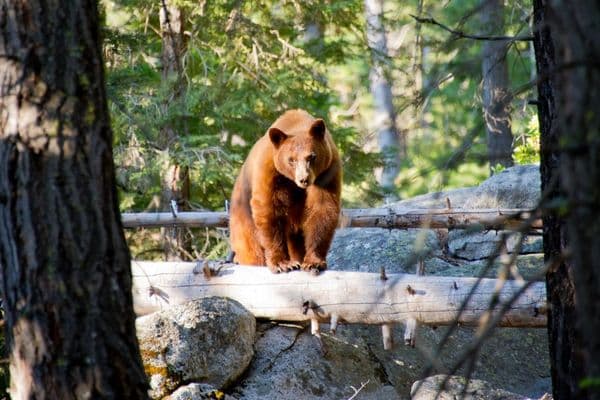
For those with a keen desire to spot a black bear in its natural environment, areas rich in berries, nuts, and water sources hold promise. The Five Lakes Trail, a 4.7-mile hike that weaves through dense forests, open glades, and a cluster of pristine alpine lakes, is prime bear territory.
Especially during late summer and early fall, when berries are abundant, you might spot bears feasting, prepping for the winter hibernation.
Another trail to consider is the Tahoe Rim Trail section between Ward Creek and Page Meadows, approximately a 6-mile stretch. Here, meadows brimming with wildflowers and diverse vegetation attract a variety of wildlife, including the elusive black bear.
This trail, with its panoramic views and lush environs, provides a backdrop that’s truly befitting for a bear sighting.
Though they may appear placid and engrossed in their activities, it’s crucial to exercise caution. Always keep a safe distance, make noise while hiking to avoid surprising them, and secure food properly when camping. Respect and understanding for these magnificent creatures are paramount.
A black bear sighting, with its blend of awe and admiration, is a testament to the wild heart of Tahoe National Forest and a memory that lasts a lifetime.
Also Read: 10 NATIONAL PARKS IN CALIFORNIA THAT HAVE BEARS!
Ospreys
The Osprey, with its striking white underbelly, sharp talons, and piercing eyes, is often referred to as the “fish hawk” for a good reason.
Expert fishers and exceptional fliers, these birds are an absolute delight to watch as they perform aerial acrobatics before diving steeply into water bodies to grasp their prey.
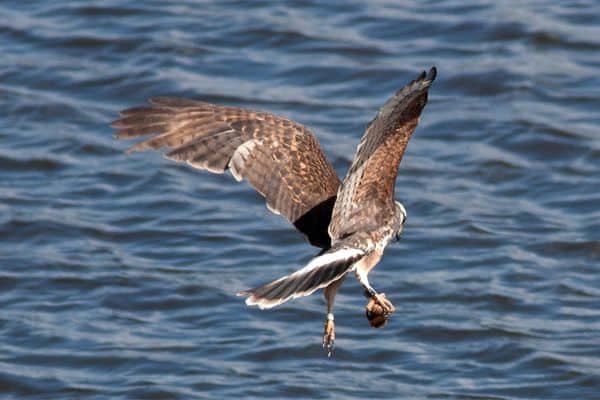
For those in Tahoe National Forest wishing to catch sight of these masterful hunters, proximity to freshwater lakes and rivers is key, as ospreys predominantly feed on fish. The Echo Lakes Trail, a 5-mile route that winds past serene alpine lakes, is an osprey hotspot.
As you hike, you might be treated to the spectacle of an osprey hovering high above, then plunging feet-first into the lake, emerging moments later with a fish firmly gripped in its talons.
Another promising path is the Truckee River Trail, which stretches for about 4.2 miles following the river’s course. The flowing waters attract a multitude of fish, making it a favorite hunting ground for ospreys.
As you amble along the riverbanks, watch the treetops for osprey nests. These large constructions of sticks and branches are hard to miss and offer an excellent vantage point for the birds to scan the waters below.
Late spring to early summer is a particularly engaging time to observe ospreys in Tahoe, as fledglings begin to learn the art of fishing under the watchful eyes of their parents.
Keep your camera ready and your senses alert. The spectacle of an osprey in action is one of the many natural wonders that make Tahoe National Forest a haven for wildlife enthusiasts.
Beavers
Often dubbed nature’s engineers, beavers are renowned for their incredible ability to transform landscapes by building dams and lodges.
With their sturdy, flat tails and sharp, chisel-like teeth, beavers in the Tahoe National Forest play a pivotal role in shaping the aquatic habitats, making them an intriguing species for nature enthusiasts to observe.
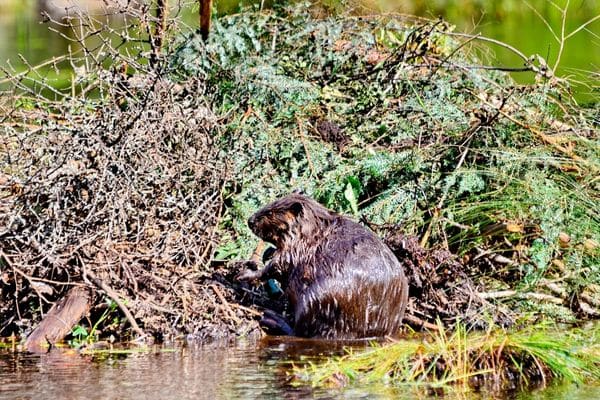
If you’re keen on spotting these industrious creatures, areas with calm freshwater sources where they can establish their lodges are your best bet. The Sagehen Creek Trail, a relatively flat 4.5-mile trek, passes through wetlands and marshy terrains, an ideal environment for beavers.
As you walk alongside the creek, you might come across a beaver dam, an intricate construction of sticks and mud, or even see one busily gnawing at tree trunks.
Another promising trail is the Stampede Reservoir Trail, which extends around 3.7 miles. The quiet waters of the reservoir, fringed by willows and aspens, offer a prime habitat for beavers.
Early morning or late evening is the most opportune time to spot them, as they tend to be more active during these cooler hours. You may witness them dragging branches, patrolling their territory, or taking a leisurely swim.
While beavers might seem docile, it’s crucial to observe them from a distance and avoid disturbing their habitats. Their role in creating wetlands and enhancing biodiversity is crucial.
As you explore the lush terrains of Tahoe National Forest, the handiwork of these master builders—evident in the ponds, channels, and lodges they create—stands as a testament to nature’s intricate web of interdependencies.
Steller’s Jay
Distinctive and bold, the Steller’s Jay is an easily recognizable resident of the Tahoe National Forest, known for its vibrant blue feathers and prominent crest.
Often likened to a blue flame flickering amidst the green foliage, this bird brings both color and charisma to the forest’s avian community.
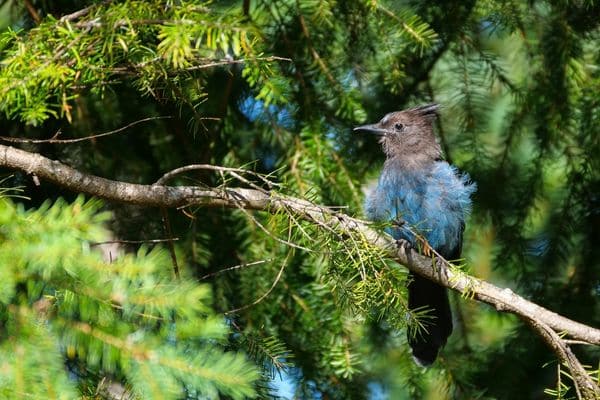
For birdwatchers and hikers eager to spot the Steller’s Jay, the dense coniferous woods of Tahoe are prime territory. One of the best trails to observe these lively birds is the Big Trees Loop Trail, a moderate 3-mile hike through old-growth forests.
Here, amidst the towering pines and firs, the jays often forage on the forest floor or perch on branches, their melodious calls echoing through the trees.
Another excellent trail is the Donner Pass Pacific Crest Trail, stretching about 5 miles. This route offers varied terrains, from rocky outcrops to lush woodlands, attracting a diverse bird population.
As you trek, the unmistakable squawk of the Steller’s Jay, sometimes imitating the calls of other birds or even human-made noises, can guide you to their presence.
While they might be known for their striking appearance, Steller’s Jays are equally famous for their intelligence and mischievous nature, often boldly approaching campsites in search of food.
As you traverse the verdant paths of Tahoe National Forest, the playful antics and vibrant hues of the Steller’s Jay serve as delightful reminders of the forest’s animated spirit.
Western Gray Squirrel
Amidst the vast, imposing landscapes of Tahoe National Forest, the nimble and lively Western Gray Squirrel adds a touch of playfulness to the wilderness.
With a sleek, silver-gray coat, bushy tail, and agile movements, these squirrels are a delightful spectacle, especially for those with an eye for the smaller wonders of the forest.
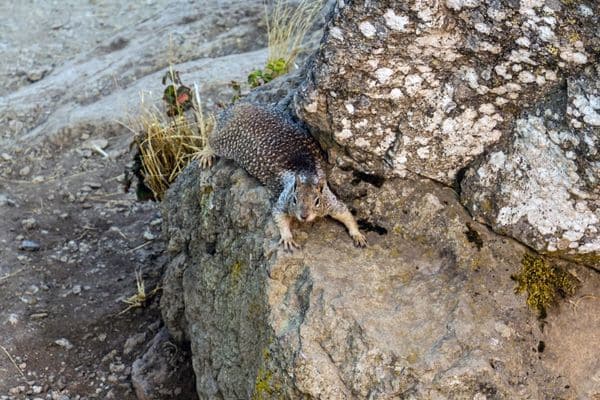
For those keen to observe these active rodents, areas with a rich understorey and plentiful oak trees are ideal. The Shirley Canyon Trail, a 4-mile route that takes hikers through varied terrains of cascading streams, granite boulders, and oak groves, is a prime spot.
As you navigate the trail, you’ll often witness Western Gray Squirrels darting up tree trunks, foraging for acorns, or playfully chasing each other in spirited games.
Another trail to mark on your map is the Grouse Ridge Lookout Trail, spanning about 5.3 miles. Alongside its breathtaking vistas and pristine lakes, the trail’s mixed coniferous forests offer ample food and shelter for the squirrels.
Here, amidst the gentle rustling of leaves and the chirping of birds, the sudden scamper or alert stance of a Western Gray Squirrel often captures one’s attention.
While they’re commonly seen during the day, these squirrels are especially active during the early mornings and late afternoons. Their inquisitive nature and swift, acrobatic movements are a joy to observe.
A simple moment watching a Western Gray Squirrel deftly maneuver through the forest, tail flicking and eyes ever-curious, encapsulates the vibrant, bustling life beneath the towering canopies of Tahoe National Forest.
Coyotes
Embodying the spirit of the American wilderness, the coyote holds a prominent place in both Native American folklore and the diverse ecosystems of Tahoe National Forest. With its keen eyes, pointed ears, and tawny coat, the coyote is a master adapter, thriving in various habitats, from dense woodlands to open meadows.
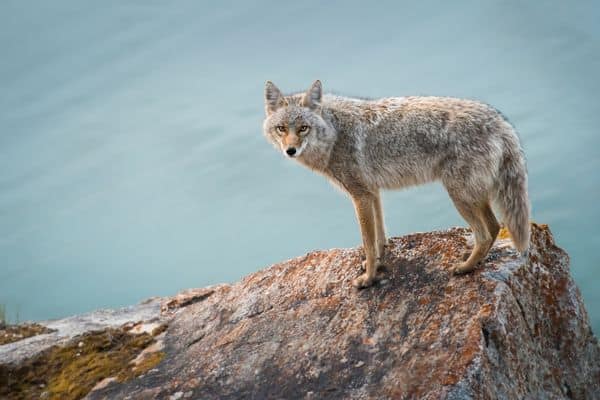
If observing this elusive canid is on your list, focus on areas where the forest meets open spaces. The Barker Pass Trail, a 7.2-mile route that offers a mix of shaded forests and open, grassy clearings, is a prime location.
Early mornings or just before sunset, when the world is bathed in soft, golden hues, you might spot a coyote on the prowl, hunting small mammals or perhaps howling to communicate with its pack.
Another trail promising potential coyote sightings is the Big Chief Trail, covering about 6.5 miles. This trail, known for its stunning rock formations and panoramic views, skirts the edges of meadows where coyotes often hunt.
Their sharp, yipping calls, echoing in the stillness, can sometimes be heard, even if the animal itself remains unseen.
Coyotes possess an air of wild intelligence and an innate survival instinct that’s captivating to observe. They often tread the line between wariness and curiosity, keeping a watchful eye on human visitors while going about their routines.
Witnessing a coyote in its natural environment, whether it’s a brief, fleeting moment or a longer observation, adds a touch of wild magic to the already enchanting landscape of Tahoe National Forest.
Sagebrush Lizard
Skittering among the shrubs and basking on sunlit rocks, the Sagebrush Lizard is one of the smaller, yet no less fascinating, inhabitants of the Tahoe National Forest.
This nimble reptile, adorned with intricate patterns and scales that range from sandy browns to bluish hues, is an integral part of the forest’s rich biodiversity.
For those with a keen interest in herpetology or simply a love for nature’s lesser-seen wonders, certain trails in Tahoe present the perfect opportunity to observe the Sagebrush Lizard.
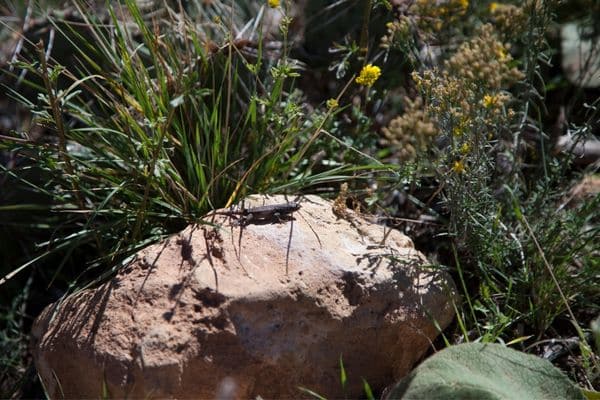
The Blackwood Canyon Trail, a 7-mile route weaving through mixed woodlands and open shrublands, is an ideal setting. As you hike through the canyon, keep an eye on sunlit rocks and fallen logs. These are favorite spots for the lizards to soak in warmth and catch insects.
Another trail worth exploring is the Sawtooth Ridge Trail, which spans about 4.6 miles. This path, with its varied terrains of dense woods and open scrublands, offers ample opportunities to spot these lizards darting between sheltered nooks or engaging in their signature push-up displays to establish territory.
Observing the Sagebrush Lizard requires a bit of patience and a keen eye. Their natural camouflage makes them blend seamlessly with their surroundings.
But the thrill of spotting one, understanding its behaviors, and admiring its delicate patterns is a rewarding experience. As you tread the diverse landscapes of Tahoe National Forest, these lizards serve as a reminder that beauty and wonder come in all sizes.
Yellow-bellied Marmot
Chunky, endearing, and often seen lounging on sun-warmed boulders, the Yellow-bellied Marmot is a delightful sight for hikers and wildlife enthusiasts traversing the Tahoe National Forest.
With their robust build, distinct yellowish-brown fur, and a penchant for high-pitched whistles, these marmots are the charismatic mascots of the alpine regions.
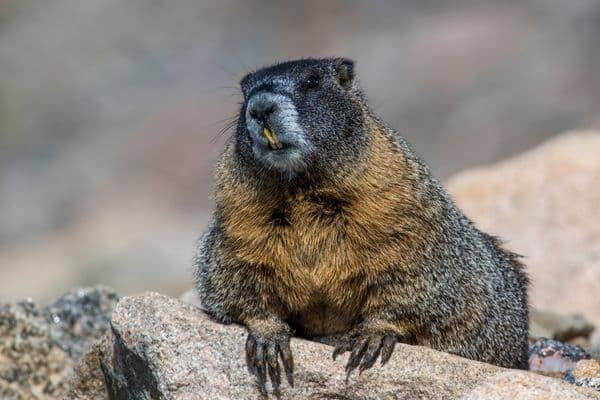
Those hoping to catch a glimpse of these sociable rodents would do well to explore areas with rocky outcrops and meadows. Granite Chief Trail, a 7.3-mile trek that navigates through alpine terrains and lush meadows, is a top spot.
As you ascend the trail’s higher elevations, you might spot marmots sunbathing on rocks or alertly standing on their hind legs, surveying their surroundings.
Another trail that promises marmot sightings is the Loch Leven Lakes Trail, spanning about 7.7 miles. This route, dotted with shimmering alpine lakes and boulder fields, offers habitats marmots thrive in.
The areas around the lakes, with their ample water sources and vegetation, are particularly bustling with marmot activity.
Whistling to communicate with their kin or to signal the approach of predators, Yellow-bellied Marmots are quite vocal. If you hear a series of sharp, piercing whistles while hiking, there’s a good chance you’re near one.
As you explore Tahoe’s breathtaking landscapes, the amusing antics and playful presence of these marmots add a touch of whimsy to the adventure, reminding us of the vibrant life that thrives even in such rugged terrains.
Raccoons
Clever, curious, and unmistakably characterized by their masked faces and bushy ringed tails, raccoons are a common yet always intriguing sight in Tahoe National Forest.
As nocturnal creatures, they’re masters of the night, often seen rummaging through the underbrush, exploring campgrounds, or even dipping their paws in water to “wash” their food—a unique behavior that’s a delight to witness.
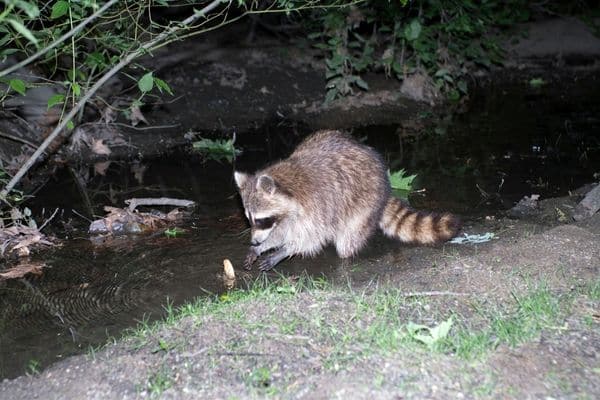
For those wishing to observe these intelligent mammals in their natural habitat, proximity to water sources and woodlands is key. The Prosser Creek Reservoir Trail, a 6-mile route that meanders along the shores of the tranquil reservoir, is an ideal spot.
As dusk settles, raccoons often emerge from the woodland edges, looking for food along the banks or playfully interacting with one another.
Another promising path is the Cottonwood Lakes Trail, about 5.4 miles long. Winding through dense forests and passing by several serene lakes, this trail provides an environment rich in food and shelter for raccoons.
If camping overnight, it’s not uncommon to hear the soft rustling of a raccoon investigating the surroundings, their innate curiosity leading the way.
While raccoons might seem endearing and approachable, it’s essential to remember they are wild animals. It’s advisable not to feed them, as this can make them dependent on human food and might lead to problematic behaviors.
Observing them from a distance and enjoying their natural behaviors is the best approach. In the diverse tapestry of Tahoe National Forest, raccoons add a layer of mystery and charm, proving that even the familiar can be wonderfully captivating in the wild.
Mule Deer
Elegant and poised, the Mule Deer, with its large, expressive ears reminiscent of a mule’s, is a hallmark sighting in Tahoe National Forest.
These graceful herbivores, distinguished by their bifurcated antlers and white-tailed rumps, navigate the forest’s varied terrains, from thick woodlands to open meadows, making them a frequent and delightful sight for visitors.
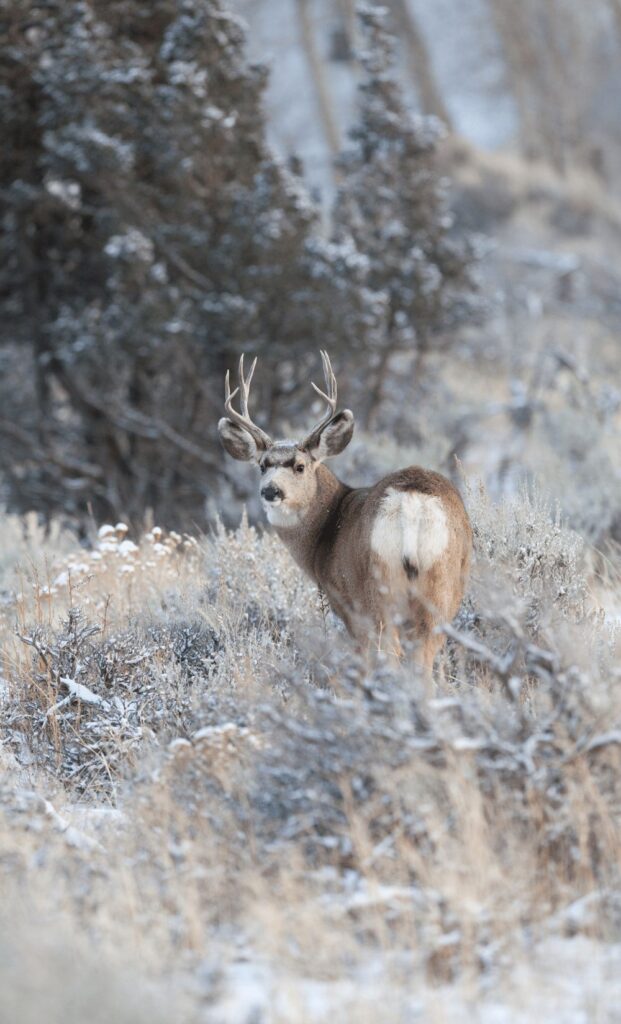
For those hoping to observe the serene beauty of Mule Deer, meadows and forest clearings are prime locations. Castle Valley Trail, a 6.5-mile loop that offers a mix of dense woods and grassy expanses, is particularly favored by these deer.
As you walk the trail, especially during dawn or dusk, you’ll often find herds grazing peacefully, their large ears constantly twitching, picking up the subtlest of sounds.
Another noteworthy trail is the Cold Stream Valley Trail, spanning about 5.7 miles. The trail, bordered by aspen groves and interspersed with meadows, is a haven for Mule Deer.
The gentle streams running through the valley provide the deer with both hydration and lush vegetation, making it a hotspot for sightings.
Mule Deer are especially active during the mating season in the fall, with males often seen locking antlers in friendly bouts. If visiting Tahoe National Forest during this time, you’re in for a special treat.
Always approach these wild animals with respect, maintaining a safe distance. Their presence, whether seen bounding through forests or merely grazing, adds a touch of wild elegance to the diverse ecosystem of Tahoe.
Striped Skunk
Often recognized by their distinctive black and white striped pattern and bushy tail, striped skunks are one of the most unmistakable residents of Tahoe National Forest.
Though primarily nocturnal, these creatures, with their waddling gait and curious nature, offer both charm and surprise to any wildlife enthusiast lucky enough to encounter them.
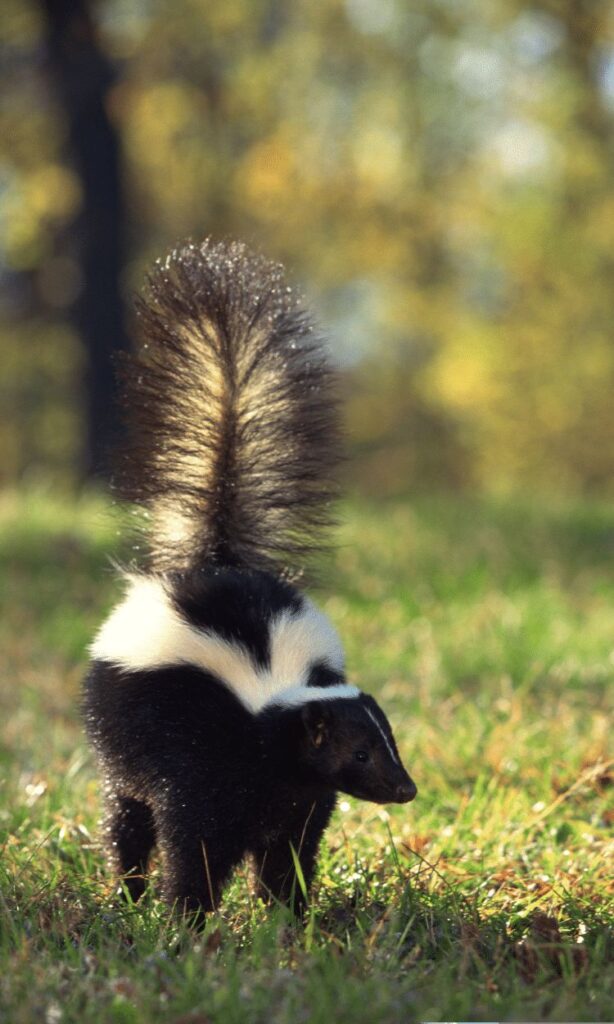
Areas where woodlands meet open spaces are prime territories for striped skunks. The Sagehen Creek Trail, a relatively flat 4.5-mile path that winds through a diverse range of habitats from dense woods to open meadows, is a favored locale.
As you walk this trail during the twilight hours, there’s a chance you might come across a skunk busily foraging for insects, small rodents, or seasonal fruits.
Another trail where skunk sightings are possible is the Donner Pass Pacific Crest Trail, stretching around 5.8 miles. This trail’s varied terrains, offering ample cover and food, make it attractive for these adaptable creatures. Areas with fallen logs and underbrush are particularly interesting, as skunks often use such spots to search for grub or shelter.
While their appearance might captivate many, it’s essential to remember the skunk’s renowned defense mechanism – a pungent spray released when they feel threatened. Always give them space and avoid sudden movements.
Observing a striped skunk in its natural environment, with its mix of beauty and natural weaponry, provides a unique and unforgettable experience, enriching the diverse tapestry of wildlife encounters in Tahoe National Forest.
Porcupine
Gentle, slow-moving, and adorned with a coat of sharp quills, porcupines are an intriguing sight in the expansive realms of Tahoe National Forest. While they may not be as frequently spotted as some of the other wildlife, their unique appearance and behavior make any encounter with them truly memorable.
For those eager to see these quill-covered herbivores, areas with abundant trees and shrubs are your best bet. The Loch Leven Lakes Trail, a 7.7-mile journey that traverses rocky terrains, forested areas, and pristine lakes, is an excellent location.
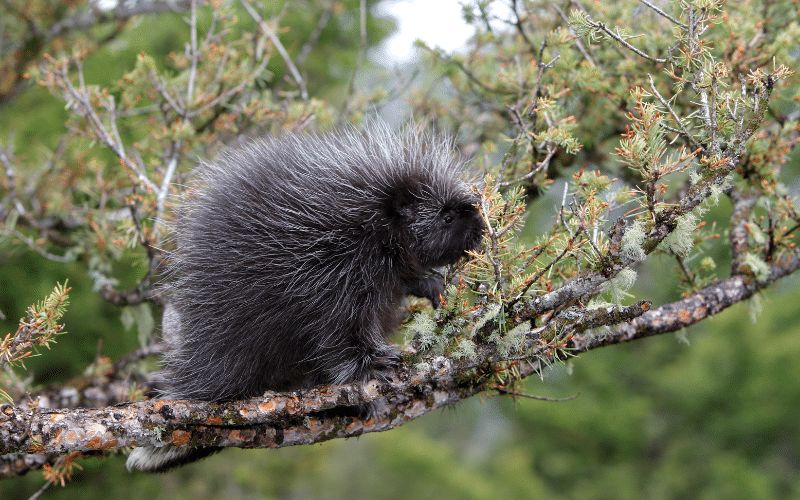
As you explore the path, keep an eye on tree branches or the ground, especially during dawn or dusk. Porcupines are fond of bark, leaves, and stems, so trees with signs of gnawing can indicate their presence nearby.
Another trail offering potential porcupine sightings is the Granite Chief Wilderness Trail, covering about 6.2 miles. This trail, with its dense coniferous forests and varied flora, provides an ideal environment for porcupines. They often frequent areas with abundant food sources, such as willow, aspen, and fir trees.
Though their quills might seem intimidating, porcupines are generally shy and will only use them as a last line of defense. It’s crucial to give them their space and not to startle them.
Watching a porcupine navigate the forest, whether clambering up a tree or shuffling along the ground, is a fascinating testament to the variety and uniqueness of wildlife within Tahoe National Forest.
12 Wildlife Abundant Hiking Trails in Tahoe National Forest
Tahoe National Forest, with its sprawling landscapes and diverse ecosystems, is a haven for wildlife enthusiasts. Among its vast expanses, certain trails stand out, offering not just breathtaking views but also promising encounters with the forest’s rich fauna.
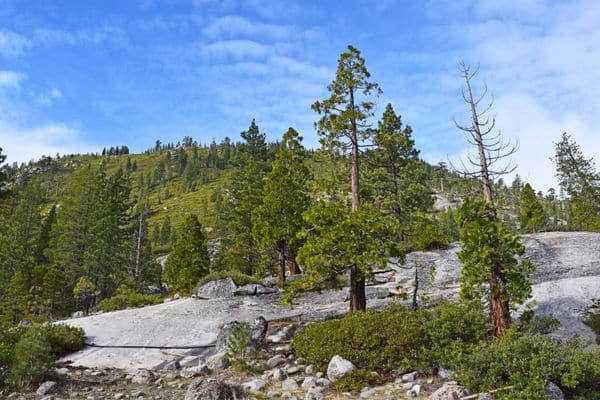
Whether you’re hoping to catch a glimpse of a nimble squirrel, the majestic flight of a bird of prey, or the elusive steps of a predator, these trails promise an enriching experience.
Here are 12 such paths that weave through habitats teeming with wildlife:
Castle Valley Trail
Spanning approximately 5.6 miles, the Castle Valley Trail is a moderately challenging route perfect for those seeking both physical exertion and nature’s beauty.
Beginning at the Castle Peak trailhead, the trail meanders through dense patches of pine, offering glimpses of the region’s varied fauna. As you hike, the undulating terrains and open meadows present the ideal habitats for numerous wildlife sightings.
Whether you’re an amateur hiker or a seasoned trekker, the Castle Valley Trail provides an invigorating experience complemented by the diverse life of Tahoe National Forest.
Cold Stream Valley Trail
Cold Stream Valley Trail is a gentle, 4.8-mile trail suitable for hikers of all skill levels.
Starting from the Cold Stream trailhead, the path unfurls amidst lush greenery, serene streams, and a quiet ambiance that seems to amplify the subtle sounds of nature. The relatively flat terrains make it an excellent choice for families or those desiring a peaceful stroll amidst wilderness.
Rich in birdlife and smaller mammals, the Cold Stream Valley Trail promises a serene escape, allowing trekkers to immerse themselves in the soothing sights and sounds of Tahoe National Forest’s diverse inhabitants.
Five Lakes Trail
Five Lakes Trail is a popular 4.7-mile round-trip trek, characterized by its moderate difficulty and the reward of stunning alpine lakes awaiting hikers at the trail’s zenith.
Starting from the Alpine Meadows trailhead, this path gradually ascends through dense woods, gradually revealing glimpses of the pristine lakes it’s named for. Along the way, the diverse habitats provide ample opportunities to spot various wildlife species.
The interconnected lakes themselves are a serene haven, reflecting the surrounding forested landscape, making the journey both a physical challenge and a visual delight for every nature enthusiast.
Tahoe Rim Trail (section between Ward Creek and Page Meadows)
A breathtaking segment of the renowned 165-mile Tahoe Rim Trail, the section between Ward Creek and Page Meadows spans approximately 7 miles.
This moderately difficult trail offers a delightful mix of shaded woods, open meadows, and panoramic views of the majestic Lake Tahoe.
Originating from the Ward Creek Boulevard trailhead, it takes hikers through varying elevations, with each turn revealing a fresh perspective of Tahoe’s expansive beauty.
As one delves deeper into the trail, encounters with local fauna are not uncommon, making this stretch a favorite among those eager to combine vigorous hiking with rich wildlife sightings.
Shirley Canyon Trail
Winding its way through the scenic depths of Shirley Canyon, the Shirley Canyon Trail is a roughly 4-mile trek that offers a moderate to challenging experience.
Starting at the base of Squaw Valley, the trail gradually ascends, taking hikers past cascading waterfalls, granite boulders, and vibrant wildflower displays during peak season. The constant murmur of Shirley Creek accompanies trekkers, providing a melodic backdrop.
As you climb higher, views of the alpine Lake Tahoe and the surrounding peaks become more prominent. The dense woods and water sources along this trail make it a hotspot for various wildlife, ensuring a mix of adventure and nature appreciation.
Grouse Ridge Lookout Trail
The Grouse Ridge Lookout Trail is a captivating 6-mile round trip that promises sweeping views and diverse wildlife encounters.
Classed as moderate in difficulty, the trailhead begins at the Grouse Ridge Campground and takes hikers through dense patches of fir and pine forests, interspersed with serene alpine lakes.
Reaching the historic Grouse Ridge Lookout, one is rewarded with panoramic vistas of the Sierra Nevada range. The trail, with its combination of water bodies and wooded areas, serves as a haven for several animal species.
Every step on the Grouse Ridge Lookout Trail is a testament to the rich biodiversity and scenic charm of Tahoe National Forest.
Barker Pass Trail
The Barker Pass Trail stretches for about 6.5 miles, presenting a moderately challenging terrain that beckons both the seasoned trekker and the enthusiastic amateur.
Originating from the Barker Pass trailhead, the trail unfolds through verdant forests and meadows, adorned with wildflowers during the spring and early summer.
The trail’s higher vantage points afford awe-inspiring views of Lake Tahoe and the surrounding peaks. The dense foliage and proximity to water sources make it a bustling corridor for various forest inhabitants.
Whether you’re looking for a vigorous workout, a serene nature walk, or an opportunity to spot some of Tahoe’s wildlife, the Barker Pass Trail delivers on all fronts.
Big Chief Trail
Big Chief Trail, a 5.5-mile loop, is renowned for its blend of historical significance and natural beauty. It starts from the trailhead near Truckee, and while it’s rated as moderate, the path promises an array of sights and sounds that encapsulate the spirit of Tahoe National Forest.
As the trail zigzags through the landscape, it passes by ancient volcanic formations and towering pines. The trail’s name pays homage to the massive granite face, resembling a chief, which is a climber’s delight.
Besides the geologic wonders, the area’s fauna, from bustling birdlife to the stealthy movements of forest mammals, ensures that the Big Chief Trail offers an enriching experience with every step.
Sagehen Creek Trail
Spanning a gentle 4.5 miles out and back, Sagehen Creek Trail is a trekker’s delight, especially for those who prefer a less strenuous hike without compromising on scenic beauty.
Commencing from the trailhead off Highway 89, the path unfolds alongside the tranquil Sagehen Creek, leading to a serene lake.
The trail is particularly popular in the spring when wildflowers blanket the meadows in a riot of colors. This water-rich environment attracts a variety of bird species and other wildlife, making it a prime spot for nature observation.
As you tread softly beside the creek, the chance encounters with Tahoe’s inhabitants amidst the peaceful ambiance make this trail a memorable experience.
Donner Pass Pacific Crest Trail
The Donner Pass Pacific Crest Trail section, stretching approximately 7.2 miles, offers a taste of the diverse landscapes and rich history of the region. Kicking off from the Donner Summit trailhead, the trail takes adventurers through terrains marked by granite outcroppings, alpine lakes, and remnants of the area’s railroad past.
Given its elevation and panoramic vantage points, hikers are often treated to breathtaking vistas of the surrounding Sierra Nevada mountains. The varied habitats along this segment of the Pacific Crest Trail provide refuge for numerous wildlife species.
From the chittering of ground squirrels to the distant calls of raptors, the Donner Pass section promises a harmonious blend of nature’s wonders and historical intrigue.
Loch Leven Lakes Trail
The Loch Leven Lakes Trail, measuring around 7.2 miles round trip, is a moderate trek that leads hikers to a trio of stunning alpine lakes.
Embarking from the trailhead located just off Interstate 80, one is immediately captivated by the path’s rocky terrain interspersed with patches of lush greenery.
As the trail ascends, hikers navigate through a series of switchbacks, with each elevation gain unveiling a more mesmerizing view of the Sierra Nevada range.
Upon reaching the lakes, the clear waters framed by dense pines offer a serene spot to relax or even take a refreshing dip. Given its aquatic and forested environments, the Loch Leven Lakes Trail teems with wildlife.
From waterfowl gracefully skimming the lake’s surface to small mammals rustling in the underbrush, there’s always a chance for a delightful wildlife encounter.
Granite Chief Wilderness Trail
Boasting a length of approximately 6.8 miles, the Granite Chief Wilderness Trail is a challenging but rewarding trek set in the heart of the Granite Chief Wilderness. Starting from the Squaw Valley trailhead, the trail offers a rugged experience as it courses through dense forests, open meadows, and across meandering streams.
The journey culminates at the Granite Chief peak, where hikers are treated to panoramic views of Lake Tahoe and the sprawling wilderness. Owing to its pristine environment, the trail is a hotspot for various fauna.
It’s not uncommon to spot deer grazing in clearings, hear the distinctive calls of mountain birds, or even catch a glimpse of a more elusive creature lurking in the shadows.
The Granite Chief Wilderness Trail, with its challenging terrains and rich biodiversity, is a must-visit for those seeking a genuine wilderness experience in Tahoe National Forest.
Tips to Maximize Your Wildlife Sightings in Tahoe
Tahoe National Forest offers a plethora of opportunities for wildlife enthusiasts, but knowing a few key tips can make the difference between a casual hike and a memorable wildlife viewing adventure. Here’s how to maximize your chances:
Best Time of Day: Understanding Animal Active Hours
- Early Morning: Many animals, especially mammals like deer and bears, are crepuscular, meaning they’re most active during dawn and dusk. Setting out early can increase your chances of spotting these creatures as they forage.
- Late Afternoon to Dusk: As the sun sets, many animals venture out once again to feed or hunt. Birds of prey, like hawks and eagles, might also be seen riding the thermals during this time.
Specific Areas of Interest: Locations Known for Frequent Sightings
- Water Bodies: Lakes, streams, and ponds are great spots as animals come to drink or hunt. Places like Loch Leven Lakes are perfect examples.
- Meadows: Open areas are ideal for spotting grazing animals such as deer and even the occasional bobcat lurking in the fringes.
- Thick Canopies: Dense forests or areas with heavy tree coverage are great for bird watching, especially woodpeckers and chickadees.
Safety Precautions: Keeping a Safe Distance and Respecting Wildlife
- Maintain Distance: Always use binoculars or a zoom lens to observe wildlife from a safe distance. Never approach or feed wild animals.
- Avoid Startling: Move quietly and avoid loud noises. If you spot an animal, observe in silence.
- Know Before You Go: Familiarize yourself with any potentially dangerous animals in the area, like bears or mountain lions, and understand how to react if you encounter one.
Gear Recommendations
- Binoculars: A good pair of binoculars can drastically improve your wildlife viewing experience, helping you spot creatures from a distance without disturbing them.
- Field Guides: Carrying a local wildlife field guide can help you quickly identify animals and birds, enhancing the educational aspect of your trip.
- Comfortable Footwear: As you might spend a lot of time standing or treading quietly, ensure you wear comfortable hiking shoes.
- Notebook & Pen: Documenting your sightings can be a fulfilling exercise and helps in tracking patterns for future visits.
By integrating these tips into your Tahoe exploration, you’ll not only heighten your chances of witnessing the forest’s wild inhabitants but also ensure a responsible and respectful wildlife experience.
Conclusion
Tahoe National Forest is a treasure trove of biodiversity, with its vast landscapes offering sanctuary to a diverse range of animals and birds. From the elusive bobcat to the soaring osprey, every corner of this magnificent forest teems with life, waiting to be discovered.
As you lace up your hiking boots and set off on the trails, remember that you are a guest in their home. Respect their space, move with care, and soak in the beauty of nature in its rawest form.
Whether you’re an avid wildlife enthusiast or a casual hiker, Tahoe promises a transformative experience, where every rustle, chirp, and footprint tells a story of nature’s grand tapestry. Here’s to many unforgettable encounters in the heart of Tahoe’s wilderness!

